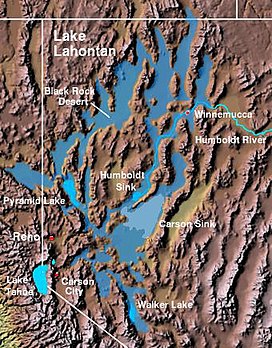Lahontan Valley
| Lahontan Valley | |
|---|---|
| Lahontan Basin | |
 The Lahontan Valley is adjacent to the Carson Sink and southwest of the Humboldt Sink. | |
| Floor elevation | 4,006 ft (1,221 m)[1] |
| Geography | |
| Country | United States |
| State | Nevada |
| District | Churchill County |
| Coordinates | 39°34′0″N 118°50′0″W / 39.56667°N 118.83333°W |
| Traversed by | U.S. Route 50 |
The Lahontan Valley is a basin in
Description

The Lahontan Valley is mostly uninhabited desert, aside from the city of
The valley derives its name from Louis-Armand de Lom d'Arce de Lahontan, Baron de Lahontan, a French soldier.[2]
Forty Mile Desert
The Forty Mile Desert is a
Per a state historical marker at a rest area at the junction of I-80 and US 95, the Forty Mile Desert was the most dreaded part of the California Trail. In Chapter XX of Roughing It, Mark Twain speaks of his traversing it during the stagecoach journey his brother and he made from Missouri to Nevada in the summer of 1861:
On the nineteenth day we crossed the Great American Desert—forty memorable miles of bottomless sand, into which the coach wheels sunk from six inches to a foot. We worked our passage most of the way across. That is to say, we got out and walked. It was a dreary pull and a long and thirsty one, for we had no water. From one extremity of this desert to the other, the road was white with the bones of oxen and horses. It would hardly be an exaggeration to say that we could have walked the forty miles and set our feet on a bone at every step! The desert was one prodigious graveyard. And the log-chains, wagon tyres, and rotting wrecks of vehicles were almost as thick as the bones. I think we saw log-chains enough rusting there in the desert, to reach across any State in the Union. Do not these relics suggest something of an idea of the fearful suffering and privation the early emigrants to California endured?
If possible, the stretch was crossed at night. An 1850 survey counted 953 graves along this portion of the trail, along with thousands of animal skeletons and abandoned belongings of the desperate travelers.[4][6]
References
- ^ a b U.S. Geological Survey Geographic Names Information System: Lahontan Valley
- ^ Federal Writers' Project (1941). Origin of Place Names: Nevada (PDF). W.P.A. p. 11.
- ISBN 0-929591-81-X.
- ^ a b "Forty Mile Desert". Nevada State Historic Preservation Office. Retrieved April 12, 2020. State Historical Marker No. 26.
- ^ "Ragtown". Nevada State Historic Preservation Office. Retrieved April 12, 2020. State Historical Marker No. 19.
- ^ "Forty Mile Desert - Virtual Tour". Oregon-California Trails Association. Archived from the original on 2011-07-25. Retrieved 2011-07-26.
External links
- Carson Trail at Emigrant Trails West, photo tour of southern wagon route across Forty Mile Desert
- Truckee Trail at Emigrant Trails West, photo tour of northern wagon route across Forty Mile Desert


